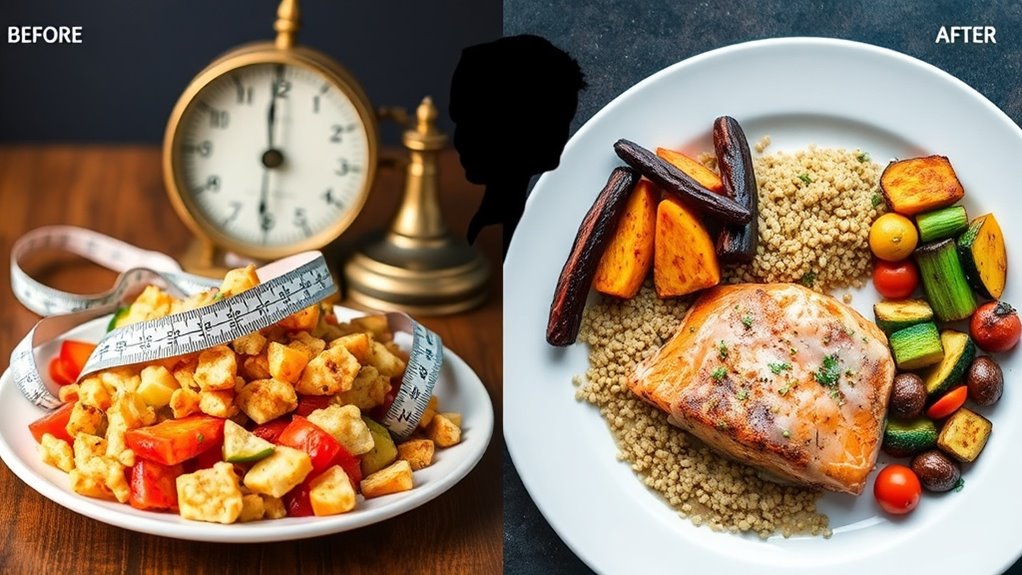Are You Eating at the WRONG Time. The Best Time to Eat for Fat Loss!
If you’re eating at the wrong times, it can sabotage your fat loss efforts! Eating earlier in the day boosts your metabolism, while late-night snacks can disrupt it. To maximize fat burning, aim to eat breakfast between 6 AM and 10 AM and keep your dinner light. Incorporating balanced macronutrients and considering intermittent fasting can further enhance your results. Curious about how to optimize your meal timing for the best results? Let’s explore more!
The Science Behind Meal Timing and Fat Loss
When it comes to fat loss, understanding meal timing can make a significant difference in your results. You mightn’t realize it, but the best eating times for weight loss can influence how effectively your body burns fat.
By aligning your meals with your daily routine, you can maximize your energy levels and boost your metabolism. Eating earlier in the day, such as having a hearty breakfast, sets a positive tone for your metabolism. This means you’ll have more energy to tackle your tasks and workouts.
Skipping meals or eating late can lead to cravings and overeating, making your fat loss journey tougher than it needs to be. Additionally, late-night snacks disrupt your metabolism, making it harder to achieve your weight loss goals.
Finding a rhythm that works for you and sticking to it fosters a sense of community. You’re not alone in this journey, and sharing your meal timing experiences can help motivate others to find their best eating times for success!
Understanding Your Body’s Circadian Rhythm
Your body’s circadian rhythm plays a crucial role in determining the best times to eat for fat loss. This internal clock regulates various biological processes, including metabolism and hormone release, impacting how your body processes food.
When you align your meals with your circadian rhythm, you can maximize fat-burning potential and improve your overall health.
Think about it: your body is naturally programmed to be more active during daylight hours. Eating in sync with this rhythm can enhance your energy levels and reduce cravings.
For example, consuming larger meals earlier in the day can help you feel satisfied and energized, while lighter meals in the evening may promote better sleep and recovery. Additionally, adequate rest is essential for regulating hunger hormones, which can further support your fat loss efforts.
Optimal Eating Windows for Maximum Fat Burning
To achieve maximum fat burning, timing your meals wisely can make a significant difference in your results. When you eat can influence how effectively your body burns fat.
Here are four optimal eating windows to consider:
-
Breakfast (6 AM – 10 AM): Kickstart your metabolism early in the day to fuel your activities.
-
Lunch (12 PM – 2 PM): Refuel your body with nutritious foods, ensuring sustained energy for the afternoon.
-
Pre-workout Snack (3 PM – 5 PM): Have a light snack about 30-60 minutes before exercising to maximize your workout performance.
-
Dinner (6 PM – 8 PM): Opt for a balanced meal to recover from your day, but avoid heavy eating right before bed. This will help prevent late-night snacking and support your overall weight loss journey.
The Role of Macronutrients in Meal Timing
Understanding the role of macronutrients in meal timing can significantly enhance your fat loss efforts. When you eat the right balance of proteins, fats, and carbohydrates at strategic times, you can optimize your body’s metabolism and energy levels.
For instance, eating protein-rich foods before your workouts can fuel your performance and promote muscle repair afterward. Carbohydrates can be your best friend post-exercise, replenishing glycogen stores to aid recovery.
Healthy fats shouldn’t be neglected either; they help maintain satiety, making you less likely to snack mindlessly. Additionally, staying properly hydrated by drinking water before meals can help reduce calorie intake and promote a sense of fullness before eating.
How Intermittent Fasting Can Aid Weight Loss
Meal timing isn’t just about what you eat; it also involves when you eat. Intermittent fasting (IF) can be a powerful tool for weight loss, helping you achieve your goals while fostering a sense of community.
Here’s how it can aid your journey:
-
Reduces Caloric Intake: By limiting your eating window, you may naturally consume fewer calories.
-
Boosts Metabolism: IF can enhance your metabolic rate, helping you burn more calories even at rest.
-
Improves Insulin Sensitivity: This can lead to better blood sugar control, reducing cravings and hunger.
-
Encourages Fat Utilization: During fasting periods, your body shifts to burning fat for energy, aiding in weight loss. Additionally, maintaining lower insulin levels during fasting promotes fat utilization, facilitating further weight loss.
Practical Tips for Implementing Strategic Meal Timing
While it may seem daunting, implementing strategic meal timing can be a game-changer for your fat loss journey. Start by identifying your daily routines and energy levels. You might find that eating larger meals earlier in the day energizes you, while smaller meals or snacks work better later on.
Try to stick to a consistent eating schedule. This helps regulate your body’s hunger cues and boosts metabolism. When you eat, focus on whole, nutrient-dense foods that keep you full longer.
Consider intermittent fasting if it resonates with you; it can simplify meal planning and enhance fat loss.
Finally, listen to your body. Pay attention to hunger signals and adjust your meal timing as needed.





